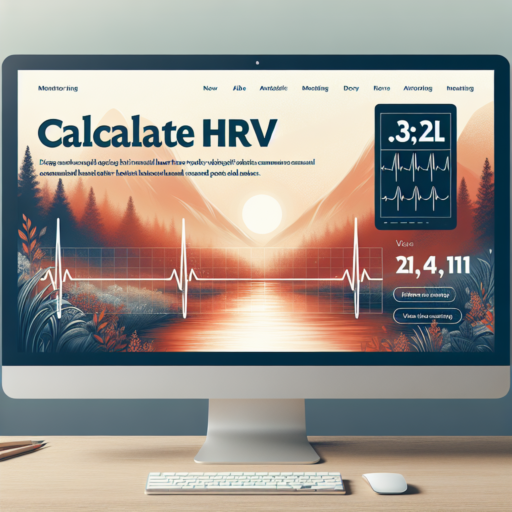Understanding the Typical HRV Range: An Introduction
Heart Rate Variability (HRV) is an essential biomarker for gauging one’s physical and emotional well-being. The typical HRV range varies widely among individuals, influenced by factors such as age, fitness level, stress, and lifestyle choices. Understanding the nuances of HRV can empower individuals to make informed decisions about their health and wellness routines.
At its core, HRV measures the variation in time between each heartbeat, which is controlled by the autonomic nervous system. A higher HRV indicates a more adaptable heart, capable of efficiently responding to stress, exercise, and relaxation. Conversely, a lower HRV may suggest stress, fatigue, or underlying health issues. It’s crucial to understand that the typical HRV range is not a one-size-fits-all metric; it’s a personalized spectrum that offers insights unique to each individual.
Many factors can influence your typical HRV range, including physical activity, sleep quality, mental stress, and even diet. A comprehensive understanding of these factors can help individuals pinpoint lifestyle adjustments to optimize their HRV. For instance, improving sleep quality or incorporating mindfulness practices can significantly influence one’s HRV, leading to improved overall health and stress resilience.
Factors That Influence Your HRV Scores
Understanding the factors that influence your HRV (Heart Rate Variability) scores is crucial for those interested in improving their overall health and well-being. HRV scores represent the variation in time intervals between heartbeats, and they are a comprehensive marker of your body’s stress levels, recovery status, and overall cardiovascular health. Various elements can impact these scores, making it essential to be aware of them for effective health management.
Physical Activity Levels
The amount and intensity of physical activity you engage in can significantly affect your HRV scores. Regular moderate exercise is known to improve HRV over time, indicating better stress resilience and cardiovascular health. However, excessive high-intensity workouts without adequate recovery can lead to decreased HRV, reflecting stress and potential overtraining. Balancing exercise intensity and recovery is key to optimizing your HRV.
Stress and Relaxation
Stress levels and your ability to relax play a pivotal role in influencing your HRV scores. Chronic stress, whether from work, personal life, or environmental factors, can suppress HRV, highlighting a body under distress. Implementing relaxation techniques such as meditation, deep-breathing exercises, or yoga can help mitigate stress impacts, potentially leading to improved HRV scores. Recognizing and managing stress is thus fundamental in maintaining optimal heart health.
Quality of Sleep
Sleep quality directly impacts HRV scores, with poor sleep patterns potentially leading to reduced HRV. Adequate, restful sleep promotes better heart rate variability, reflecting the body’s ability to recuperate and manage stress more effectively. Consistency in sleep schedules, optimizing sleep environments, and addressing sleep disorders are constructive steps towards enhancing HRV through improved sleep quality.
How to Interpret Your HRV Range for Better Health
Understanding your Heart Rate Variability (HRV) is a crucial step towards managing your physical well-being and enhancing your health. HRV refers to the variance in time intervals between your heartbeats, and it’s a valuable metric for assessing your autonomic nervous system’s flexibility. Your HRV range can provide insightful data about your stress levels, recovery status, and overall heart health.
When interpreting your HRV, a higher score typically signifies better health, indicating that your body can efficiently adapt to stress and recover. Conversely, a lower HRV may suggest that your body is under stress, either due to physical strain, emotional stress, or potential health issues. To get a comprehensive understanding of what your HRV range tells you, regular monitoring and trend analysis are key. Over time, you’ll be able to identify what a «normal» HRV score looks like for you and how deviations from this norm can reflect changes in your health or stress levels.
Factors Influencing Your HRV
- Physical activity: Regular exercise can improve your HRV, but excessive training without ample recovery can lead to a decrease.
- Stress and relaxation: High stress levels can lower your HRV, whereas practices like meditation and breathing exercises can increase it.
- Sleep quality: Poor sleep patterns can negatively affect your HRV, highlighting the importance of good night’s rest for heart health.
By keeping a close eye on your HRV and understanding the factors that influence it, you can make informed decisions about your health routines. Paying attention to how your actions and environmental factors affect your HRV can guide you towards healthier lifestyle choices, improving your heart health and overall well-being.
No se han encontrado productos.
The Importance of HRV: Insights from Health Experts
Understanding the significance of Heart Rate Variability (HRV) is key to unlocking insights into one’s overall health and well-being, according to health experts. HRV refers to the variation in time between each heartbeat, which is considered a comprehensive marker revealing the health of the autonomic nervous system. This variability is not just a metric for athletes but is equally important for the general population, offering clues about stress, recovery, and even the potential risk of certain health conditions.
HRV as a Predictor of Health and Longevity: Health professionals emphasize HRV’s role in predicting health outcomes and longevity. A higher HRV has been linked with resilience, a stronger cardiovascular system, and lower stress levels, whereas a lower HRV is associated with an increased risk of heart disease and premature death. By monitoring HRV, individuals have the opportunity to understand their body’s response to stressors and make lifestyle adjustments accordingly.
Key Benefits of Monitoring HRV
- Enhanced Stress Management: By recognizing patterns in HRV, individuals can better understand their stress triggers and work towards managing stress more effectively.
- Improved Cardiovascular Health: Regular monitoring of HRV can aid in detecting early signs of cardiovascular issues, allowing for preventative measures to be taken.
- Optimized Training for Athletes: Athletes can use HRV data to tailor their training programs, maximizing performance while minimizing the risk of overtraining.
In the realm of personal health management, the importance of HRV is gaining recognition among health experts. As research continues to uncover its potential benefits and applications, HRV monitoring is becoming an essential tool for anyone looking to enhance their health and longevity. By paying close attention to HRV, individuals can make informed decisions about their lifestyle, stress management, and overall health strategies.
Normal HRV Ranges by Age and Gender: What You Need to Know
Understanding Heart Rate Variability (HRV) is crucial for interpreting our body’s health and fitness levels. HRV measures the variation in time between each heartbeat, serving as an indicator of your autonomic nervous system’s efficiency. It’s a fascinating health metric that reflects our body’s ability to handle stress, recover, and adapt. However, what does «normal» look like, and how does it vary with age and gender? Let’s dive deep into the normal HRV ranges by age and gender to shed light on this vital health parameter.
First and foremost, it’s essential to acknowledge that HRV is highly individualized. What’s normal for one person might be low or high for another. Nonetheless, general patterns have been observed. For instance, HRV tends to decrease as we age, reflecting the natural decrease in our autonomic nervous system’s flexibility. Moreover, gender differences also play a significant role; typically, men may have slightly higher HRV values compared to women of the same age group. This variation underscores the importance of contextualizing HRV readings within the broader spectrum of individual health profiles.
Age-specific HRV Ranges: Research indicates distinctive trends across different age groups. In young adults (18-25 years), HRV can be relatively high, signifying robust heart health and stress resilience. As individuals transition into middle age (26-50 years), a gradual decline in HRV is often observed, coinciding with lifestyle factors and natural aging. For seniors (50+ years), maintaining an HRV within the lower range of their age-specific bracket can still denote good health, particularly if they engage in activities that enhance cardiovascular health.
Improving Your HRV: Lifestyle Changes and Strategies
Improving your Heart Rate Variability (HRV) is fundamental for overall health and wellness. HRV refers to the variation in the time interval between heartbeats and is a reliable marker of the autonomic nervous system’s flexibility. Enhancing your HRV can lead to better stress management, improved cardiovascular condition, and increased resilience to health challenges. Here, we focus on lifestyle changes and strategies designed to boost your HRV, contributing to an enriched quality of life.
Adopt a Balanced Diet
A balanced diet plays a crucial role in regulating autonomic functions and, by extension, improving HRV. Consuming a variety of nutrients can positively impact your heart’s health and its ability to respond to stress. Emphasizing the intake of omega-3 fatty acids, antioxidants, and phytonutrients found in fruits, vegetables, and whole grains is beneficial. Incorporating these dietary changes can bolster heart health and enhance HRV over time.
Incorporate Regular Physical Activity
Regular physical activity is another vital component in the quest to improve HRV. Exercise, especially aerobic activities, stimulates heart function and promotes a more variable heart rate. Even habitual low-impact exercises like walking, yoga, or cycling can have significant positive effects. It’s crucial to find a form of exercise that suits your lifestyle and preferences to maintain consistency and enjoy the health benefits, including a higher HRV.
Stress management techniques such as mindfulness, meditation, and deep-breathing exercises can also notably enhance HRV. Practices that promote relaxation and mental calmness have been shown to increase the variability of the heart rate, indicating a healthier response to stress and environmental demands. Regularly dedicating time to these stress-reducing activities can be a game-changer in improving not only HRV but overall mental and physical health.
HRV Tracking Devices: How to Choose the Best One for You
When looking to invest in your well-being, HRV (Heart Rate Variability) tracking devices stand out as a sophisticated tool to gauge your physical fitness, stress levels, and overall health. With the multitude of options on the market, identifying the perfect fit for your needs can be daunting. Here, we’ll navigate through some key features and considerations to help you make an informed decision.
Understanding Your Needs and Preferences
Before diving into the vast sea of HRV tracking devices, it’s crucial to pinpoint exactly why you need one. Are you a professional athlete seeking to optimize your performances, or perhaps someone interested in managing stress and improving general health? The purpose behind your interest significantly narrows down your choices, allowing you to focus on devices that cater specifically to your goals.
Accuracy and Reliability
In the realm of HRV tracking, precision matters. Devices utilize different technologies to monitor heart rate variability, leading to variations in accuracy. Look for devices that use electrocardiogram (ECG) sensors for the most precise readings, as opposed to those relying solely on optical sensors, which may be less accurate. Reviewing technical specifications, along with user feedback, can shed light on a device’s reliability, ensuring you invest in a gadget that delivers solid and dependable data.
Usability and Compatibility
Lastly, a device’s ease of use and compatibility with other technology is paramount. Consider if you prefer a wearable constantly tracking your metrics or a static device for periodic assessments. Additionally, ensure the device pairs seamlessly with your smartphone or computer, providing an intuitive interface for analyzing your HRV data. Choosing a device that fits effortlessly into your lifestyle not only enhances your experience but also ensures you’ll consistently use it over time.
Common Misconceptions About HRV Ranges Demystified
When it comes to understanding heart rate variability (HRV), several misconceptions can lead to confusion. HRV ranges, a critical indicator of an individual’s physiological resilience and stress levels, are often misunderstood. In this section, we’ll clarify some of the most common misconceptions about HRV ranges, providing a clearer understanding of what they truly indicate about your health.
Misconception 1: A Higher HRV is Always Better
One of the most prevalent misconceptions is the idea that a higher HRV is universally beneficial. While it’s true that a higher HRV can indicate better cardiovascular fitness and stress management, it’s not a one-size-fits-all metric. Extremely high HRV values can sometimes indicate underlying health issues or imbalances in the autonomic nervous system. Therefore, it’s essential to consider HRV readings within the context of an individual’s overall health status and lifestyle.
Misconception 2: HRV Ranges are Consistent Across All Age Groups
Another widespread misunderstanding is that HRV ranges remain consistent regardless of age. However, HRV tends to decline as we age, reflecting changes in the autonomic nervous system’s functionality. Comparing HRV values across different age groups without accounting for this natural progression can lead to inaccurate interpretations. Recognizing age-specific HRV ranges allows for more precise assessments of heart health and stress resilience.
Understanding these common misconceptions about HRV ranges can significantly improve how individuals monitor their health and well-being. By acknowledging the nuanced nature of HRV and its relationship with various health indicators, people can make more informed decisions about their lifestyle and interventions to improve their overall health. Stay informed and consult with healthcare professionals to interpret HRV measurements appropriately for your personal health context.
Maximizing Your HRV: Tips from Professional Athletes
Heart Rate Variability (HRV) has become a buzzword in the realms of fitness and wellness, especially among professional athletes. HRV refers to the variation in time intervals between heartbeats, and it’s a critical indicator of autonomic nervous system function and overall health. Mastering HRV can lead to enhanced performance, better stress management, and improved recovery times. So, how do elite athletes maximize their HRV?
Understanding the Basics of HRV
Before diving into strategies to maximize HRV, it’s essential to understand its fundamentals. Professional athletes monitor their HRV to gauge their body’s readiness for training and competition. A higher HRV indicates a well-rested body that’s ready for intense activities, whereas a lower HRV suggests the need for recovery. By paying close attention to these variations, athletes can tailor their training programs to align with their body’s recovery state, significantly reducing the risk of overtraining and injury.
Adopting Specific Breathing Techniques
Breathing exercises are a cornerstone strategy used by athletes to enhance their HRV. Techniques such as diaphragmatic breathing, box breathing, and the 4-7-8 method can help activate the parasympathetic nervous system, leading to increased HRV levels. These methods not only improve heart function but also provide a calming effect on the mind, making them perfect for pre-competition nerves and improved sleep quality.
Incorporating Active Recovery Days
Rather than considering rest days as doing nothing, professional athletes focus on active recovery. Activities like light yoga, swimming, and even walking can boost HRV by promoting blood flow and reducing muscle stiffness without putting too much stress on the body. This approach ensures that the body remains in motion, facilitating better nutrient distribution and faster recovery while still allowing the heart rate to normalize and HRV to increase.
Conclusion: Integrating HRV Range Knowledge into Your Daily Life
Integrating Heart Rate Variability (HRV) range knowledge into your daily routine can serve as a powerful tool to enhance your overall well-being and performance. As we understand the implications of our HRV scores, we pave the way for more informed decisions about stress management, exercise, and recovery. With an awareness of when your HRV is indicating stress or recovery, you can tailor your daily activities to better support your body’s needs.
One practical step in incorporating this knowledge is to begin by tracking your HRV regularly with a smart wearable or a dedicated HRV monitor. This consistent tracking will help you notice patterns and identify what activities or times of day correspond to higher or lower HRV readings. From here, you can start to make small adjustments to your daily schedule, such as incorporating relaxation techniques when your HRV indicates stress or optimizing your workout routines based on days when your HRV suggests peak physical readiness.
Moreover, understanding your HRV range can empower you to prioritize sleep and recovery more effectively. For instance, noticing a trend of lower HRV scores may suggest the need for more restful sleep or perhaps a review of your current stressors and recovery strategies. Consequently, by keeping a close eye on your HRV, you’ll not only optimize your physical performance but also ensure that your approach to stress and recovery is as dynamic and responsive as your body is.




